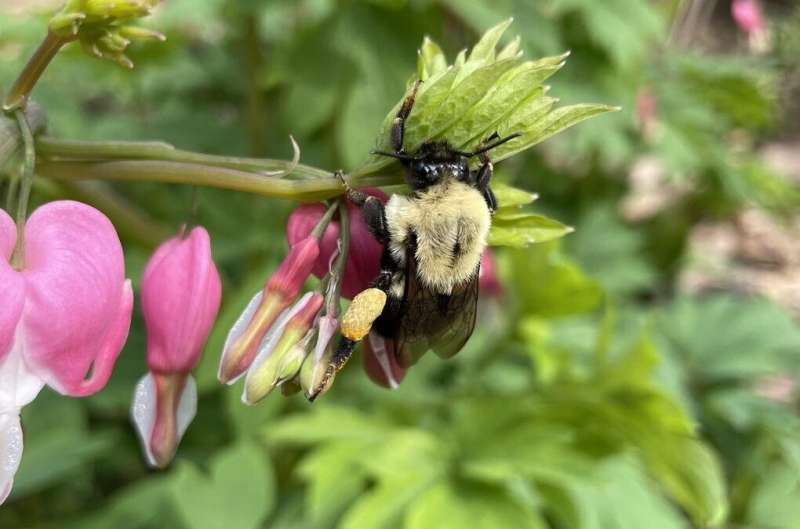‘Nature is messy’: Pioneers in landscape transcriptomics study genes in the wild

An interdisciplinary team in Penn State’s College of Agricultural Sciences—in an initiative aimed at better understanding the implications of climate change for animal and plant life and agricultural systems—is focusing on an emerging field of study called landscape transcriptomics.
In an invited technical review paper recently published in Molecular Ecology Resources, team leader Jason Keagy, assistant research professor of wildlife behavioral ecology, explained that landscape transcriptomics studies how patterns of gene expression in living organisms relate to changes in environment—including habitat, weather, climate and contaminants—as well as the subsequent effects on the function of plants and animals.
He explained that a transcriptome is the total of all the RNA molecules expressed from the genes of an organism, essentially a collection of all the gene readouts present in a cell. By looking at finer scale gene expression differences over larger scale environments, trends emerge that offer new insight into how life on Earth is adapting to change, he said.
We sat down with Keagy to learn more about the new, complex field.
Q: What is landscape transcriptomics?
Keagy: Transcriptomics is the study of all the RNA molecules in a given tissue at a certain point in time. Why do we care about RNA? DNA is basically a memory-storage device. For a gene to actually do anything, the letters of DNA must be rewritten as letters of RNA and then translated into a protein.
We can literally read the RNA letters to find out which genes are active and how active they are. We can then ask: How is the active part of the DNA code affected by an environmental stressor? That’s where the landscape part comes in. Typically, we would do experiments to answer this question. But some things just can’t be studied well in the lab. Nature is messy and understanding that messiness is important.
So, what if we instead grabbed samples from across the landscape and asked how some variable—temperature, altitude, shade—influenced gene expression, the transcriptome? That, in a nutshell, is landscape transcriptomics.
Q: What can researchers accomplish using landscape transcriptomics?
Keagy: In the paper we just published, we outline three major areas of research that we envision landscape transcriptomics will address: understanding molecular pathways involved in response to the environment, generating and testing hypotheses about the mechanisms and evolution of these responses to the environment, and applying this knowledge to species conservation and management.
The first two are important from the point of view of understanding how organisms respond to the environment, whereas the third is important from a more practical point of view.
Q: What are practical applications of this approach?
Keagy: We envision a number of ways landscape transcriptomics can be used for conservation and management. One way is in the development of biomarkers. For example, we could survey brook trout from various streams over a period of time to discover a set of genes that reliably tracks temperature stress. Using this information, we could identify populations that are at risk and target them for habitat or other mitigation.
We could also identify populations that are especially resilient to thermal stress and use those for reintroduction or assisted migration. Because gene expression flexibly responds to the environment and because we can often get tissue through non-lethal means—for example, by extracting a tiny piece of gill—it could allow us to much better track population stress.
Under a potential future scenario, a technician conducting an electro-fishing survey for the Pennsylvania Fish and Boat Commission could take a small piece of gill, put it in a provided vial to preserve it, and mail to Penn State. We would be able to tell the commission whether that fish was exhibiting signs of thermal stress or other stressors for which we had information.
Q: Why isn’t everyone already using this approach?
Keagy: Genomic sequencing is expensive, but it is getting cheaper. We point out in our paper that it is possible to get samples sequenced with certain technologies below $100 per sample. That price will likely continue to come down as there are new generation sequencers coming onto the market.
There are also challenges to the approach both from an experimental design and statistical analysis side. We discuss these in the paper and offer some suggestions, although point out that the field could benefit from more work in figuring out the best way to do analysis efficiently.
The landscape transcriptomics initiative at Penn State—which includes Christina Grozinger, Publius Vergilius Maro Professor of Entomology; Heather Hines, associate professor of biology and entomology; and Tyler Wagner, assistant unit leader USGS Cooperative Fish and Wildlife Research Unit and adjunct professor of fisheries ecology—received a Strategic Networks and Initiatives Program Grant Level I from the College of Agricultural Sciences.
More information:
Jason Keagy et al, Landscape transcriptomics as a tool for addressing global change effects across diverse species, Molecular Ecology Resources (2023). DOI: 10.1111/1755-0998.13796
Citation:
‘Nature is messy’: Pioneers in landscape transcriptomics study genes in the wild (2023, May 12)
retrieved 12 May 2023
from https://phys.org/news/2023-05-nature-messy-landscape-transcriptomics-genes.html
This document is subject to copyright. Apart from any fair dealing for the purpose of private study or research, no
part may be reproduced without the written permission. The content is provided for information purposes only.
For all the latest Science News Click Here
For the latest news and updates, follow us on Google News.

